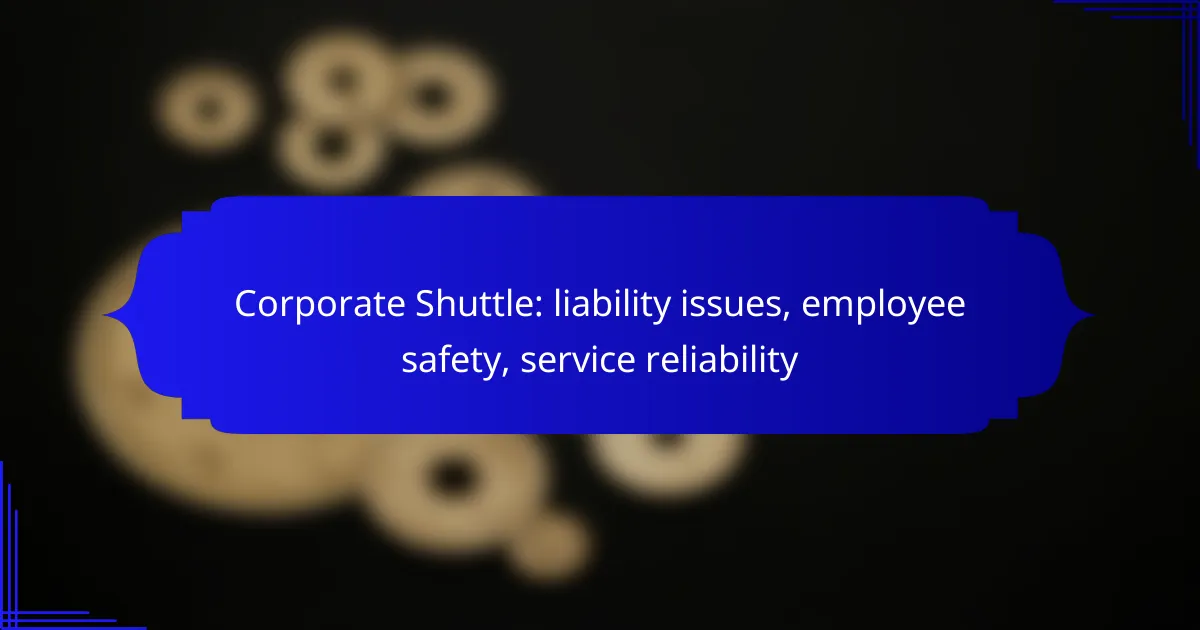Corporate shuttles play a crucial role in employee transportation, but they come with significant liability issues that companies must address. Ensuring employee safety through rigorous vehicle maintenance, driver training, and emergency preparedness is essential to mitigate risks. Additionally, service reliability is achieved through effective fleet management and real-time tracking, which together enhance the overall shuttle experience for employees.

What are the liability issues with corporate shuttles in the UK?
Liability issues with corporate shuttles in the UK primarily revolve around insurance coverage, negligence claims, and compliance with regulations. Companies must navigate these aspects to ensure employee safety and minimize legal risks.
Insurance requirements
In the UK, corporate shuttle services must have adequate insurance coverage to protect against potential liabilities. This typically includes public liability insurance, which covers injuries to third parties and damage to property, as well as employer’s liability insurance for employee-related claims. Companies should verify that their insurance policies meet the minimum legal requirements and consider additional coverage for specific risks associated with shuttle operations.
It’s advisable to regularly review and update insurance policies to reflect changes in operations or regulations. Engaging with an insurance broker who specializes in transport services can help ensure comprehensive coverage tailored to the company’s needs.
Negligence claims
Negligence claims arise when a corporate shuttle service fails to meet the standard of care expected, leading to accidents or injuries. For instance, if a driver is found to be unqualified or if the vehicle is poorly maintained, the company may be held liable for any resulting harm. To mitigate these risks, companies should implement rigorous driver training programs and regular vehicle inspections.
Documenting safety protocols and maintaining clear records can also serve as evidence of due diligence in the event of a claim. Establishing a culture of safety within the organization is crucial to prevent incidents that could lead to negligence claims.
Regulatory compliance
Corporate shuttles in the UK must comply with various regulations, including those set by the Driver and Vehicle Standards Agency (DVSA) and local transport authorities. Compliance involves ensuring that vehicles meet safety standards, drivers possess the necessary licenses, and the service adheres to operational guidelines. Failure to comply can result in fines, legal action, or suspension of services.
Companies should stay informed about changes in transport regulations and engage with legal experts to ensure ongoing compliance. Regular training sessions for staff on regulatory requirements can help reinforce the importance of adherence to these laws.

How can companies ensure employee safety during shuttle services?
Companies can enhance employee safety during shuttle services by implementing comprehensive training for drivers, maintaining vehicles rigorously, and establishing clear emergency response plans. These measures collectively minimize risks and ensure a reliable transport experience for employees.
Driver training programs
Effective driver training programs are crucial for ensuring employee safety during shuttle services. These programs should cover defensive driving techniques, safe passenger handling, and emergency protocols. Regular assessments and refresher courses can help maintain high standards.
Companies should consider including simulations and real-world scenarios in their training to prepare drivers for various situations. Additionally, verifying that drivers have the necessary licenses and clean driving records is essential to reduce liability risks.
Vehicle maintenance protocols
Regular vehicle maintenance protocols are vital for ensuring the safety of shuttle services. Companies should establish a routine inspection schedule that includes checking brakes, tires, lights, and other critical systems. Keeping detailed maintenance logs can help track the condition of each vehicle and ensure compliance with safety regulations.
Using a checklist for maintenance tasks can streamline the process and ensure no critical areas are overlooked. Companies should also consider using certified mechanics for repairs and servicing to enhance reliability and safety.
Emergency response plans
Having well-defined emergency response plans is essential for addressing incidents during shuttle services. These plans should outline procedures for various emergencies, including accidents, medical issues, and vehicle breakdowns. Training employees on these plans can improve response times and outcomes.
Companies should conduct regular drills to ensure both drivers and passengers are familiar with emergency protocols. Additionally, providing clear communication channels for reporting incidents can help manage situations effectively and reduce liability exposure.

What factors contribute to service reliability in corporate shuttles?
Service reliability in corporate shuttles hinges on effective fleet management, real-time tracking, and regular audits. These elements ensure that shuttles operate efficiently, maintain safety standards, and meet employee transportation needs consistently.
Fleet management software
Fleet management software is essential for overseeing shuttle operations, including vehicle maintenance, scheduling, and driver performance. By integrating these functions, companies can optimize routes and reduce downtime, leading to improved reliability.
When selecting software, consider features like automated maintenance alerts and reporting tools. These can help identify potential issues before they affect service, ensuring that shuttles remain in good working condition.
Real-time tracking systems
Real-time tracking systems enhance service reliability by providing up-to-date information on shuttle locations and estimated arrival times. This transparency allows employees to plan their schedules better and reduces wait times.
Implementing GPS tracking can also help in managing delays caused by traffic or road conditions. By communicating these delays promptly, companies can adjust schedules and keep employees informed, thereby improving overall satisfaction.
Regular service audits
Conducting regular service audits is crucial for maintaining high standards in shuttle operations. These audits evaluate vehicle condition, driver performance, and compliance with safety regulations, ensuring that all aspects of service are reliable.
Establish a routine audit schedule, ideally quarterly, to identify areas for improvement. This proactive approach can help mitigate risks and enhance the overall reliability of corporate shuttle services.

What are the best practices for selecting a corporate shuttle provider?
To select a corporate shuttle provider, prioritize safety, reliability, and customer satisfaction. Conduct thorough evaluations of potential providers based on their safety records, customer reviews, and service contracts to ensure a high-quality experience for employees.
Evaluating safety records
Assessing the safety records of corporate shuttle providers is crucial for employee protection. Look for providers with a strong history of safety compliance, including adherence to local regulations and standards. Request documentation of their safety performance, such as accident rates and maintenance protocols.
Consider providers that have certifications from recognized safety organizations. A good benchmark is to choose companies with accident rates significantly lower than the industry average, which can often be found in annual reports or safety audits.
Assessing customer reviews
Customer reviews provide valuable insights into the reliability and quality of a shuttle service. Check online platforms, such as Google Reviews or Yelp, to gauge overall satisfaction and common concerns. Look for patterns in feedback, particularly regarding punctuality, vehicle condition, and driver professionalism.
It’s beneficial to reach out to other businesses that use the same provider. Personal recommendations can highlight strengths or weaknesses that may not be apparent in public reviews, helping you make a more informed decision.
Comparing service contracts
When comparing service contracts, focus on the terms that affect service reliability and costs. Key elements to review include pricing structures, cancellation policies, and liability coverage. Ensure that the contract clearly outlines the responsibilities of both parties in case of service disruptions.
Consider negotiating terms that allow for flexibility, such as adjustments in service frequency or routes based on employee needs. A well-structured contract can protect your company from unexpected costs and ensure a consistent level of service.

How do corporate shuttle services impact employee productivity?
Corporate shuttle services significantly enhance employee productivity by reducing commute times and stress, allowing staff to arrive at work ready to engage. These services streamline transportation, leading to better time management and overall job satisfaction.
Reduced commute stress
Corporate shuttles alleviate the stress associated with daily commuting by providing a reliable and comfortable mode of transport. Employees can avoid the frustrations of traffic congestion and parking challenges, which often lead to anxiety and decreased focus.
By offering a dedicated shuttle service, companies can help employees use their commute time more effectively, whether by relaxing, catching up on emails, or preparing for the day ahead. This can lead to a more positive mindset upon arrival at work.
Increased punctuality
Shuttle services contribute to higher punctuality rates among employees by providing a consistent schedule that minimizes delays. When employees rely on a corporate shuttle, they are less likely to encounter unexpected obstacles that can hinder their arrival time.
For example, a well-timed shuttle can ensure that employees arrive at the office within a predictable timeframe, reducing the likelihood of tardiness. This reliability fosters a culture of accountability and professionalism within the workplace.
Enhanced work-life balance
Corporate shuttle services promote a better work-life balance by freeing up personal time that employees would otherwise spend commuting. With reduced travel times, employees can dedicate more time to family, hobbies, or self-care, leading to improved overall well-being.
Furthermore, the convenience of a shuttle service can make it easier for employees to manage their schedules, allowing for flexible work arrangements. This balance not only enhances job satisfaction but can also lead to increased loyalty and retention within the company.

What emerging trends are shaping corporate shuttle services?
Corporate shuttle services are increasingly influenced by trends such as sustainability, technology integration, and enhanced employee safety. These trends are driving companies to adopt more efficient, reliable, and eco-friendly transportation solutions for their workforce.
Liability issues
Liability issues in corporate shuttle services primarily revolve around accidents and employee safety. Companies must ensure that their vehicles meet safety standards and that drivers are properly trained to minimize risks. Additionally, organizations should have comprehensive insurance coverage to protect against potential claims arising from incidents.
To mitigate liability, businesses can implement strict safety protocols, conduct regular vehicle maintenance, and keep detailed records of employee training. Establishing clear policies regarding passenger behavior can also help reduce the likelihood of accidents.
Employee safety
Employee safety is a top priority for corporate shuttle services, especially in urban environments. Companies should assess routes for potential hazards and ensure that shuttles are equipped with safety features, such as seat belts and emergency exits. Regular safety drills and training sessions can further enhance employee preparedness.
Providing real-time tracking and communication tools can also improve safety by allowing employees to share their location with designated contacts. This transparency helps ensure that employees feel secure while using shuttle services.
Service reliability
Service reliability is crucial for corporate shuttle services, as delays can impact employee productivity and satisfaction. Companies should invest in technology that allows for real-time tracking and updates, helping to manage expectations and improve overall service quality.
Establishing a robust scheduling system that accounts for traffic patterns and employee needs can enhance reliability. Regular feedback from employees can also inform adjustments to routes and schedules, ensuring that the service remains efficient and responsive to user demands.
